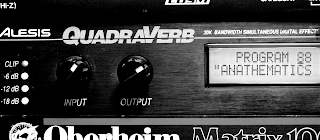
Quadraverbs are crusty sounding old rack mounted effects units. They clip far too easily. The stereo inputs are summed to mono before the effects processing. All the sound editing is done via strange pressure sensitive up/down buttons that scroll the values faster if you press harder. The reverbs are crappy and noisy and everything going through it comes out sounding gritty. Despite all this, the Quadraverb is a fun toy to have around.
The highlights of the Quadraverb are...
1. Midi Modulation
There are eight midi controller routings in the Quadraverb. That means you can connect a midi controller and tweak eight different parameters at once. Just about any effects parameter can be mapped to a controller. However, like most older midi gear, the Quadraverb can get a bit overwhelmed by too much midi data.
Here's a clip of a drum loop running through the Quadraverb with the delay time and feedback being modulated in realtime. I used midi clip envelopes in ableton live so the modulations create a loop.
2. Resonators
The resonators patch in the Quadraverb consists of 6 resonant filters. The twist is that the frequency of the filters is controlled by midi. This means you can play the filters with a keyboard or a sequencer. It seems to work best on percussive sounds. Here's a sample of a drum loop running through the resonator while it's triggered from a midi keyboard.
3. Ring modulator
The ring modulator in the Quadraverb is a bit different to other ring modulators I've come across. It splits the ring modulator into two outputs, an "Up" and a "Down" which according to the manual are the frequencies above and below the modulator frequency. According to Sound on Sound magazine they are the Sum and Difference outputs.
Ring modulators require two different signals. The quadraverb ring modulator has a built in oscillator for the second signal. It is a sine wave and ranges from 0-300 Hz which is a bit limiting compared with the moogerfooger ring modulator which goes up to 4000 Hz. The interesting sounds come out when you vary the oscillator frequency via midi.
Here is a sample of a sine wave fed into the ring modulator followed by some reverb and delay. The frequency of the ring modulator is being varied via midi.
It's all in the name of science. Weird Science.
There is a great article in Sound on Sound about creating "strange ethereal textures". The quadraverb is mentioned several times, in particular it's ring modulator and resonators. I followed some of the tips in the article to create a texture from the ring modulated sample above.
The ring modulated sound needed more "body" so I added a layer of bass using a low pass filtered triangle wave.
The SOS article mentions adding gentle percussion sounds in the background gives a pad a more haunting sound. You can hear this trick on the Roland JV synths where they use an Angklung loop in the background of some of the Pad sounds. Not having an Angklung handy, I settled for a recording I made of some cutlery rattling around in the kitchen sink. Liberal amounts of reverb and delay where applied. I read somewhere that delay is sonic MSG, in which case this sample is Singapore noodles at the Lucky Dragon Restaurant.
The final sample was made by mixing the three layers in ableton live using clip envelopes for the individual volumes.
The layered sample was then loaded into a sampler (actually the simpler plugin) and a bunch chords were played. It's not quite Eric Persing but the result is kind of strange and ethereal. If you are interested, the individual wav samples are here.
nice post, sorry that the sound clips not are available
ReplyDeleteSure they are--check the link to archive.org at the end of the article. And yeah, great post, trying to reproduce some of these effects now, thanks!
DeleteSure they are--check the link to archive.org at the end of the article. And yeah, great post, trying to reproduce some of these effects now, thanks!
Delete